Research on the Calculation Method and Diffusion Pattern of VCE Injury Probability in Oil Tank Group Based on SLAB-TNO Method
Abstract
:1. Introduction
2. Methodology
2.1. Method Construction
2.2. Case Study Scenario Description
- -
- The accident scenario involves the instantaneous leakage leading to the spread of a liquid pool;
- -
- The area of the liquid pool under instantaneous leakage is equal to the cofferdam area;
- -
- There is 90% of the liquid vaporized at the formation of the liquid pool, and the liquid mass fraction is 0.1;
- -
- Propane is used as a substitute for LPG;
- -
- The saturated vapor pressure of propane satisfies the Clapeyron equation;
- -
- There are numerous obstacles in the calculation, and the explosion severity level in the TNO model is 5.
3. Results and Discussion
3.1. Comparison of Results Between the TNO Method and SLAB-TNO Method
3.2. Effects of Wind Speed on Casualty Probability
3.3. Effects of LFL on Casualty Probability
3.4. Effects of Environment Temperature on Casualty Probability
4. Conclusions
- (1)
- Under the effects of gas diffusion, the area with a personnel injury probability diffusion of 0.9 at 100 s is larger than calculated using the SLAB-TNO method. After 100 s, the combustible cloud mass reduces because of diffusion, and the hazardous area shrinks. The consequence of a VCE accident considering gas diffusion may be greater than that without considering gas diffusion;
- (2)
- Wind can promote the diffusion of combustible gas. When the wind speed reaches 5 m/s, there is no gas with the concentration above the LFL. Increasing the wind speed will reduce both the upper and lower boundaries of the probability contour lines for casualties. The changing of the central point coordinates can be ignored. Increasing the wind speed will decrease the accident consequences at the target point;
- (3)
- Increasing the LFL will reduce the mass and shrink the boundaries of the flammable gas clouds, assuming the diffusion of gas clouds remains unchanged. When the LFL increases from 0.0189 kg/m3 to 0.0756 kg/m3, the mass of the flammable gas cloud decreases by 37.1%. Due to the greater concentration gradient of gas clouds on the lee side, increasing the LFL has a more significant impact on the downstream position of the flammable gas cloud, resulting in the movement of the explosion center point toward the upstream. The reduction of LFL will significantly increase the consequences of VCE;
- (4)
- Increasing the environmental temperature promotes gas diffusion. The combustible gas cloud concentration in the core area is 14.4% at an environmental temperature of 253 K, while the concentration decreases to 12.8% at an environmental temperature of 253 K. The increase in environmental temperature causes the gas cloud in the core area to spread towards the edge, increasing the mass of the flammable gas cloud. The mass reaches its maximum value of 6.79 × 104 kg at 313 K. An increase in ambient temperature will only slightly increase the consequences of VCE.
Author Contributions
Funding
Data Availability Statement
Conflicts of Interest
References
- Xu, Q.M.; Chen, G.H.; Xie, M.L.; Li, X.F.; Zhao, Y.M.; Su, S.; Li, S.M. Experimental and numerical studies on hydrogen leakage and dispersion evolution characteristics in space with large aspect ratios. J. Clean. Prod. 2024, 438, 140467. [Google Scholar] [CrossRef]
- Yang, Y.; Chen, G.; Zhao, Y. A Quantitative Framework for Propagation Paths of Natech Domino Effects in Chemical Industrial Parks: Part I—Failure Analysis. Sustainability 2023, 15, 8362. [Google Scholar] [CrossRef]
- Yang, Y.; Chen, G.; Zhao, Y. A Quantitative Framework for Propagation Paths of Natech Domino Effects in Chemical Industrial Parks: Part II—Risk Assessment and Mitigation System. Sustainability 2023, 15, 8306. [Google Scholar] [CrossRef]
- Zeng, T.; Chen, G.; Yang, Y.; Reniers, G.; Zhao, Y.; Liu, X. A Systematic Literature Review on Safety Research Related to Chemical Industrial Parks. Sustainability 2020, 12, 5753. [Google Scholar] [CrossRef]
- Beji, T.; Merci, B. Development of a numerical model for liquid pool evaporation. Fire Saf. J. 2018, 102, 48–58. [Google Scholar] [CrossRef]
- Galeev, A.D.; Starovoytova, E.V.; Ponikarov, S.I. Numerical simulation of the consequences of liquefied ammonia instantaneous release using FLUENT software. Process Saf. Environ. Prot. 2013, 91, 191–201. [Google Scholar] [CrossRef]
- Galeev, A.; Ponikarov, S. Numerical investigation of flammable vapour cloud formation from pools of heated organic liquids. Heliyon 2022, 8, 20. [Google Scholar] [CrossRef] [PubMed]
- Penelon, T.; Debuy, V.; Truchot, B.; Wagner, C.; Donnat, L.; Lechaudel, J.F. Pool evaporation: Experimental tests at medium-scale with gasoline. J. Loss Prev. Process Ind. 2020, 65, 104072. [Google Scholar] [CrossRef]
- Qian-Xi, Z.; Yu, Y.; Wen-Bing, Y.; Dong, L. The sensitivity of final consequence analysis results to the LNG pool area. In Proceedings of the 2014 7th International Conference on Intelligent Computation Technology and Automation, Changsha, China, 25–26 October 2014; pp. 840–843. [Google Scholar] [CrossRef]
- Luketa-Hanlin, A. A review of large-scale LNG spills: Experiments and modeling. J. Hazard. Mater. 2006, 132, 119–140. [Google Scholar] [CrossRef] [PubMed]
- Zheng, Y.P.; Guo, J.J.; Liu, X.X.; Su, X.K. Study on Theory of Hazardous Gas Puff Dispersion. In Proceedings of the 1st International Conference on Energy and Environmental Protection (ICEEP 2012), Hohhot, China, 23–24 June 2012; pp. 1625–1629. [Google Scholar]
- Gavelli, F.; Hendrickson, B.; Kooy, R.; Kolade, B. Evaluation protocols for flammable and toxic dispersion models. Process Saf. Prog. 2022, 41, 362–371. [Google Scholar] [CrossRef]
- Fthenakis, V.M. HGSYSTEM: A review, critique, and comparison with other models. J. Loss Prev. Process Ind. 1999, 12, 525–531. [Google Scholar] [CrossRef]
- Alakalabi, A.; Liu, W.M. Numerical Investigation into the effects of obstacles on heavy gas dispersions in the atomsphere. In Proceedings of the 12th International Conference on Computational Heat, Mass and Momentum Transfer (ICCHM2T), Rome, Italy, 3–6 September 2019. [Google Scholar]
- Liao, N.; Huang, K.; Chen, L.Q.; Wang, Z.F.; Wu, J.; Zhang, F. Numerical simulation of gas dispersion during cold venting of natural gas pipelines. Adv. Mech. Eng. 2018, 10, 1687814018755244. [Google Scholar] [CrossRef]
- Rich, T.; Vanderwel, C. Pollutant Dispersion Around a Single Tall Building. Bound.-Layer Meteorol. 2024, 190, 34. [Google Scholar] [CrossRef]
- Li, Z.L.; Simancas, N.S.N.; Vianna, S.S.V.; Zhang, B. A mathematical model for hydrogen dispersion cloud based on dimensional analysis and computational fluid dynamics (CFD). Int. J. Hydrogen Energy 2024, 60, 229–240. [Google Scholar] [CrossRef]
- Khan, S.; Hassan, Q. Review of developments in air quality modelling and air quality dispersion models. J. Environ. Eng. Sci. 2021, 16, 1–10. [Google Scholar] [CrossRef]
- He, J.X.; Liu, L.; Li, A.G.; Ma, Y.; Zhou, D.M.; Zhou, Q.Y.; Zhan, Y.Z. A dense gas dispersion model based on revised meteorological parameters and its performance evaluation. Atmos. Environ. 2021, 244, 117953. [Google Scholar] [CrossRef]
- Weiping, D. Modeling accidental releases toxic chemical release. Chem. Eng. Prog. 2005, 101, 33–39. [Google Scholar]
- Gronwald, F. Predicting Pollutant Concentration Using Multiple Air Dispersion Models in a 2-D Superensemble. Ph.D. Thesis, North Carolina Agricultural and Technical State University, Greensboro, NC, USA, 2016. [Google Scholar]
- Oran, E.S.; Chamberlain, G.; Pekalski, A. Mechanisms and occurrence of detonations in vapor cloud explosions. Prog. Energy Combust. Sci. 2020, 77, 100804. [Google Scholar] [CrossRef]
- Qian, X.M.; Feng, C.G.; Chen, L.S. Comparison study among the models to evaluate the consequence of vapor cloud explosion. In Proceedings of the Asia Pacific Symposium on Safety 2005, Shaoxing, China, 2–4 November 2005; pp. 194–198. [Google Scholar]
- Alonso, F.D.; Ferradás, E.G.; Sáncheza, T.D.J.; Aznar, A.M.; Gimeno, J.R.; Alonso, J.M. Consequence analysis to determine the damage to humans from vapour cloud explosions using characteristic curves. J. Hazard. Mater. 2008, 150, 146–152. [Google Scholar] [CrossRef] [PubMed]
- Cozzani, V.; Salzano, E. The quantitative assessment of domino effect caused by overpressure—Part II. Case studies. J. Hazard. Mater. 2004, 107, 81–94. [Google Scholar] [CrossRef] [PubMed]
- GB 50160-2008; Fire Prevention Code of Petrochemical Enterprise Design. Chinese Standard: Beijing, China, 2008.




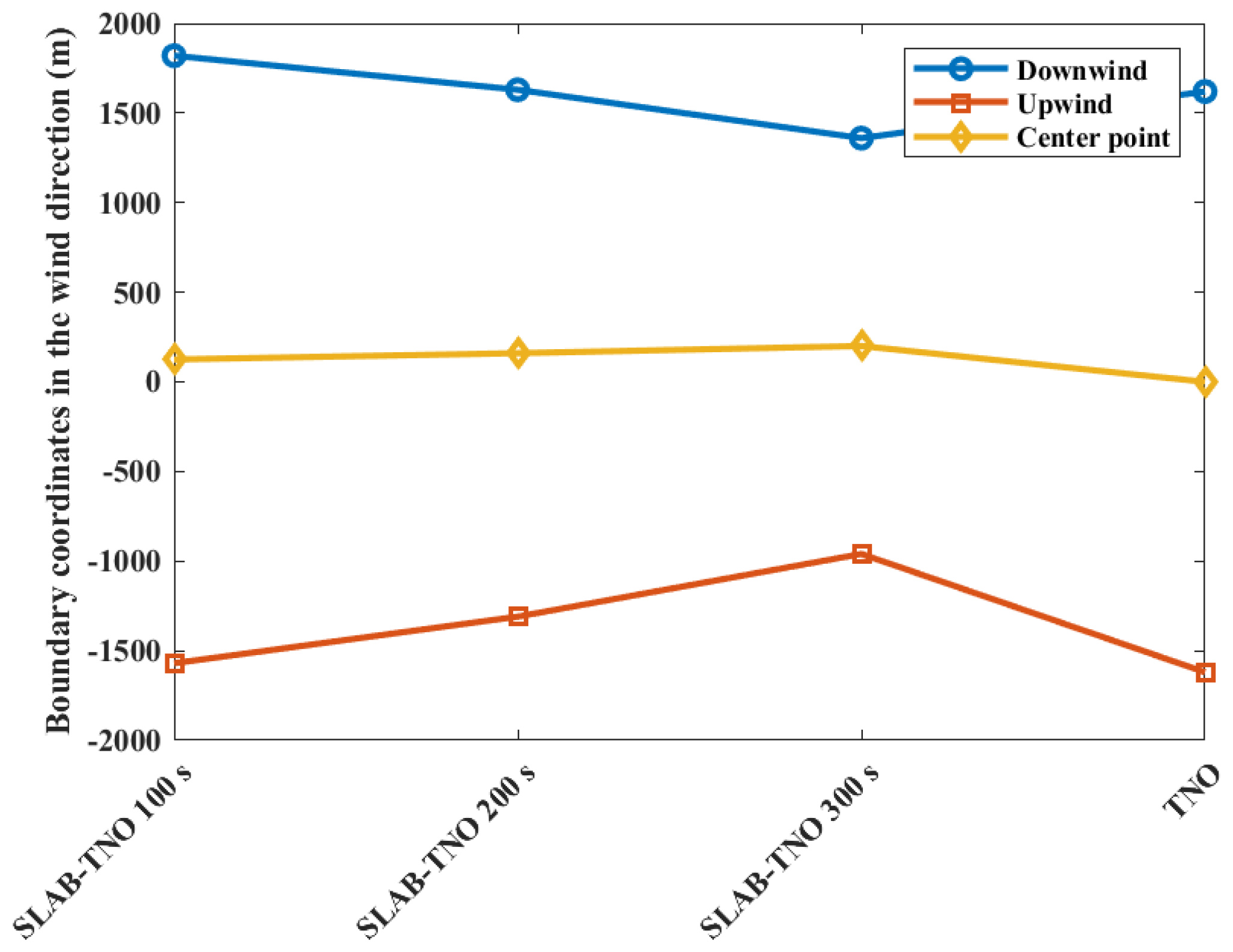
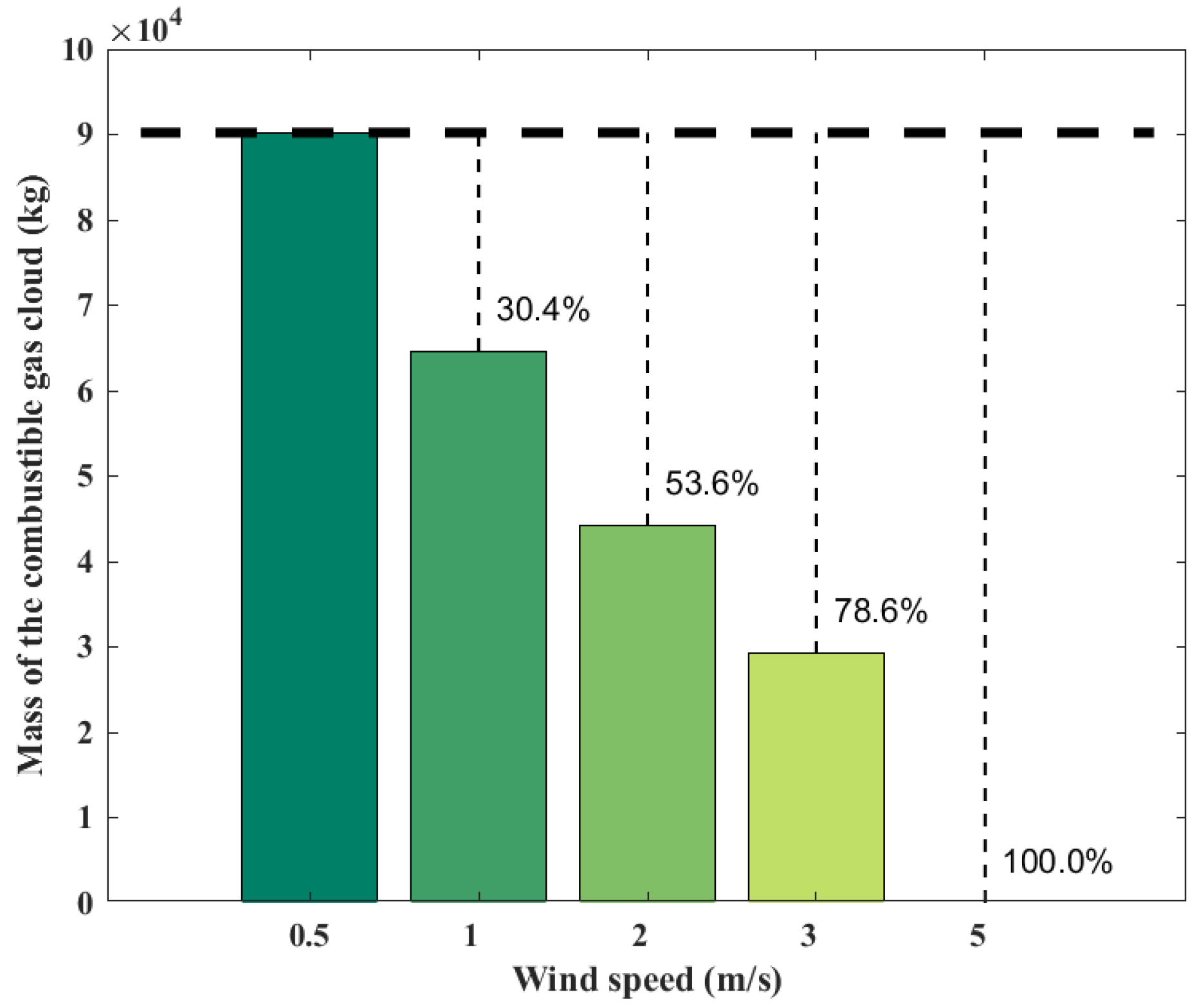
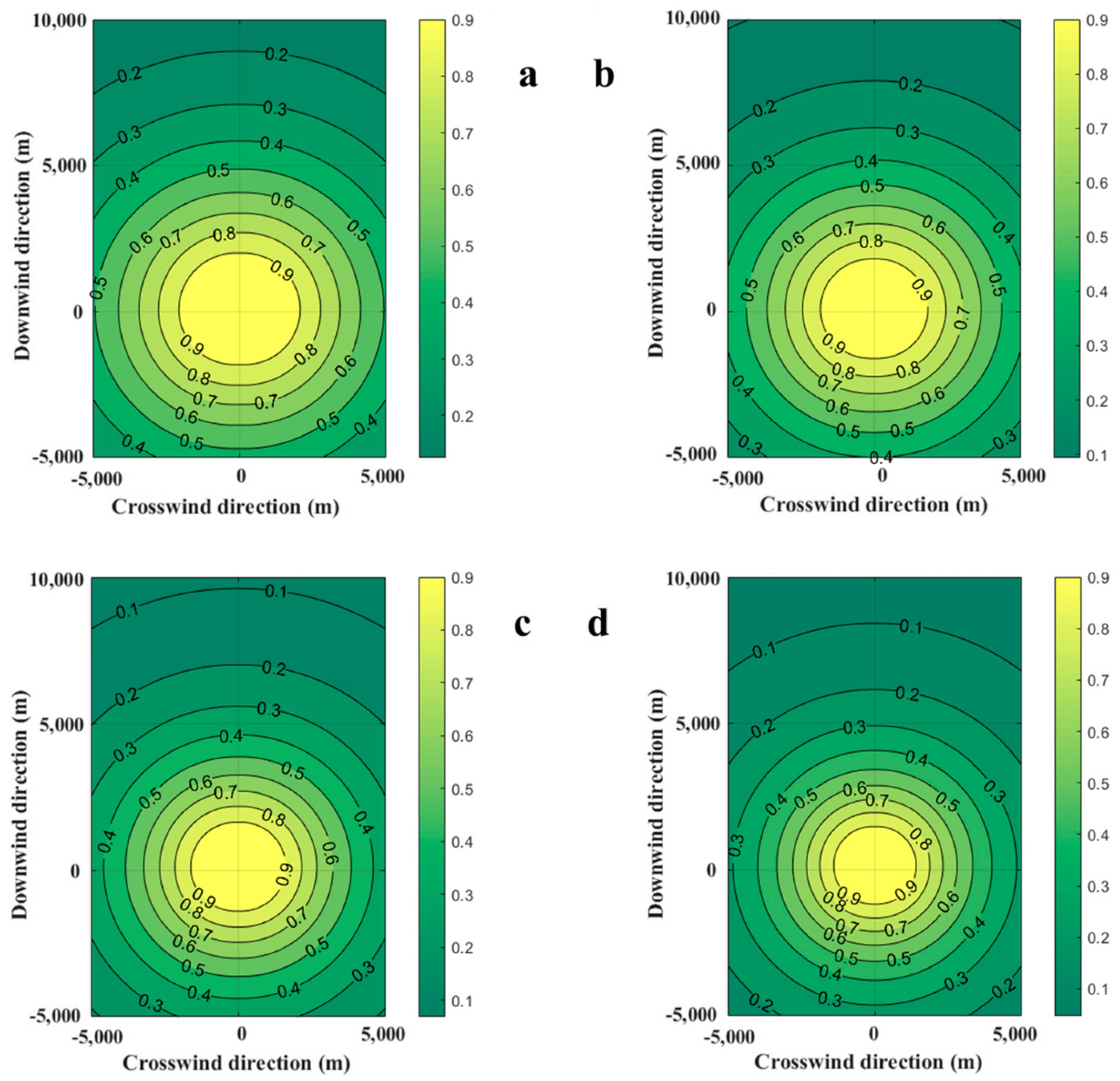

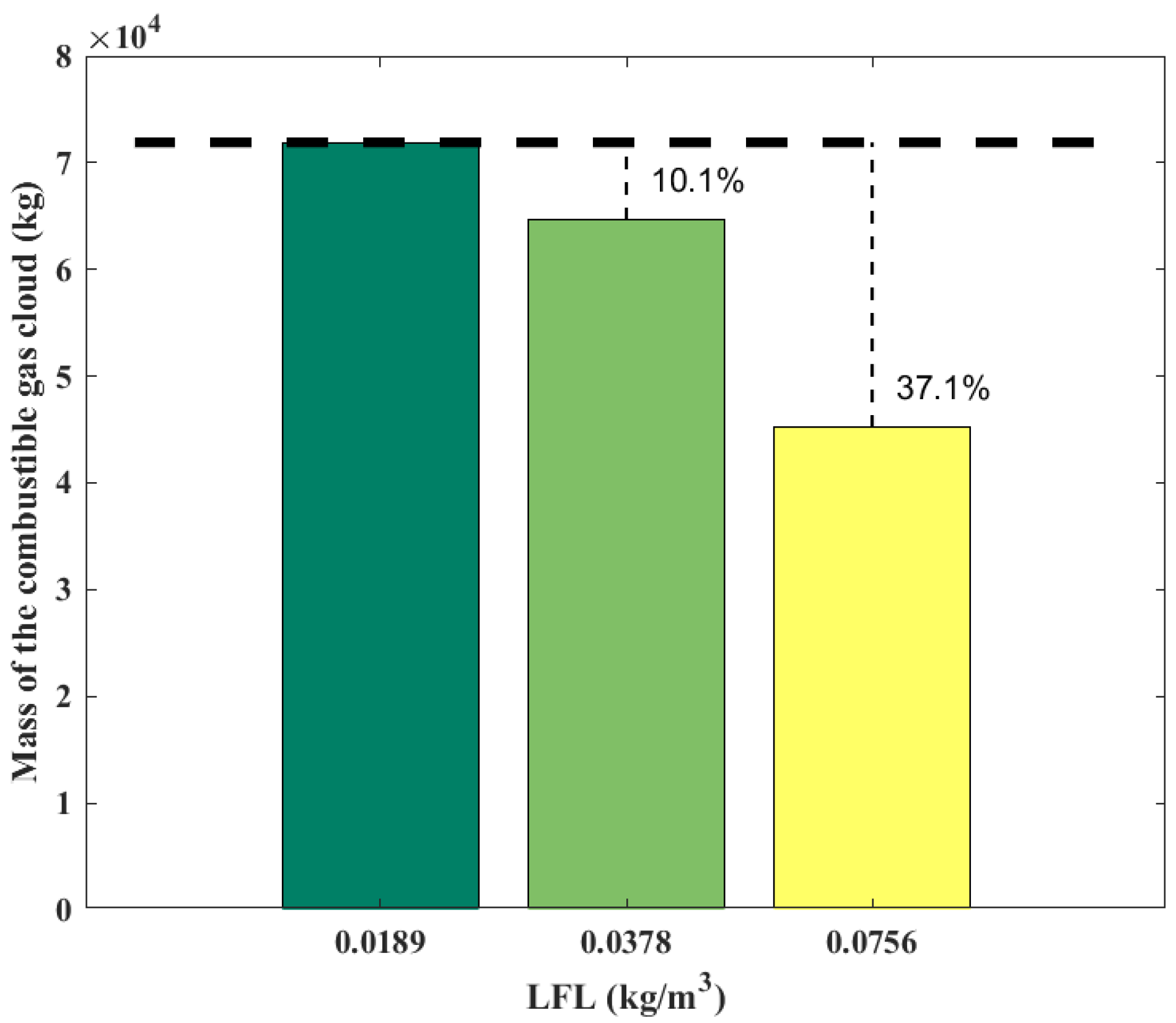
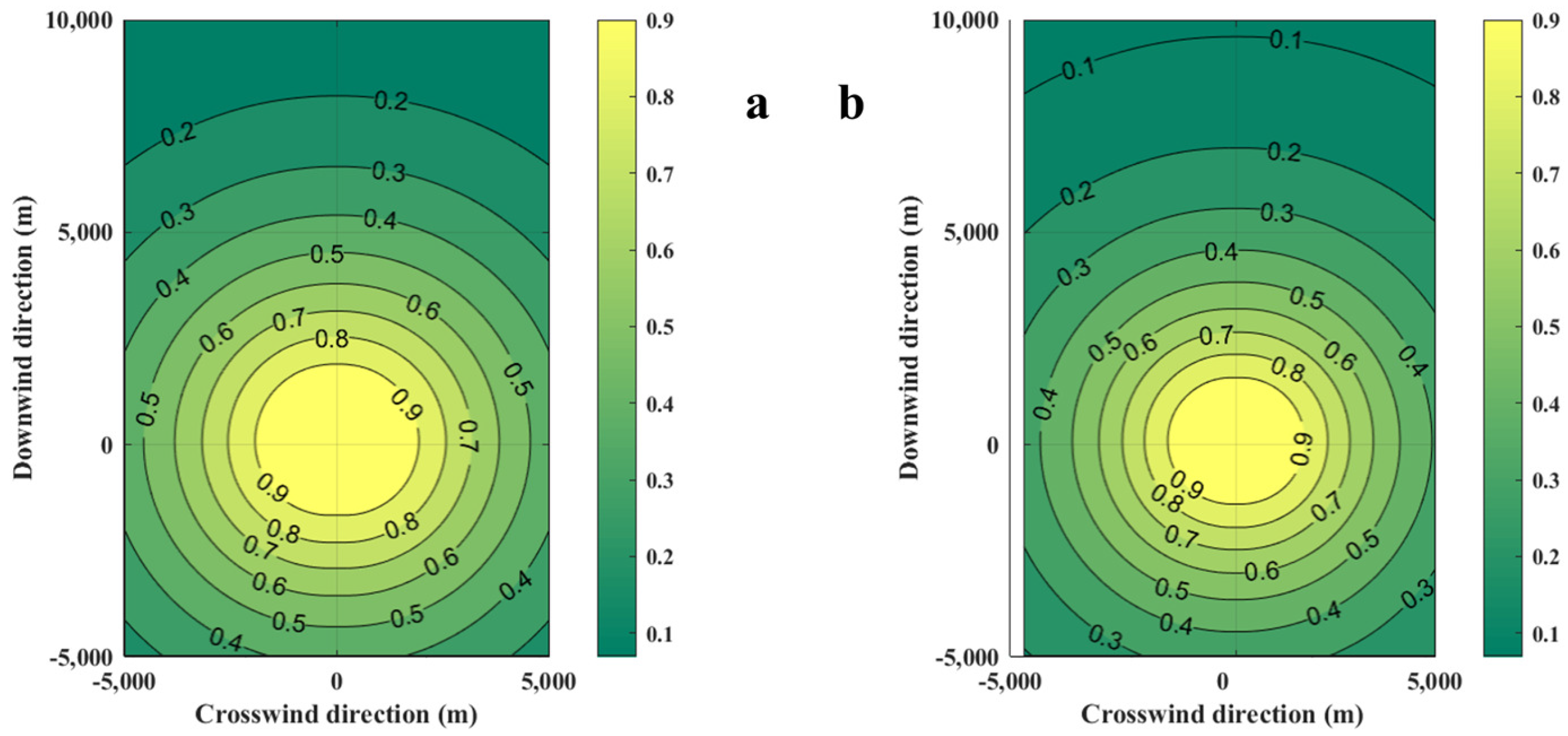




| Material Parameters | |
|---|---|
| Molar mass (kg/mol) | 44.1 × 10−3 |
| Heat capacity of steam at constant pressure (CPS) (J/kg/K) | 1678.9 (298.15 K, gas), 2519 (298.15 K, liquid) |
| Boiling point (K) | 231 |
| Latent heat of vaporization (J/kg) | 3.44 × 105 |
| Density (kg/m3) | 580 (liquid), 1.83 (gas) |
| Saturation vapor pressure (Pa) | 5.332 × 103 |
| Heat of combustion (J/kg) | 4.65 × 107 |
| Leakage temperature (K) | 298.15 |
| LFL (kg/m3) | 0.0378 |
| Pool Parameters | |
| Pool area (m2) | 200 |
| Environment Parameters | |
| Wind speed (m/s) | 1 |
| Environment temperature (K) | 289 |
| Relative humidity (%) | 30 |
| Atmospheric stability | D |
| Surface roughness (m) | 0.03 |
Disclaimer/Publisher’s Note: The statements, opinions and data contained in all publications are solely those of the individual author(s) and contributor(s) and not of MDPI and/or the editor(s). MDPI and/or the editor(s) disclaim responsibility for any injury to people or property resulting from any ideas, methods, instructions or products referred to in the content. |
© 2024 by the authors. Licensee MDPI, Basel, Switzerland. This article is an open access article distributed under the terms and conditions of the Creative Commons Attribution (CC BY) license (https://creativecommons.org/licenses/by/4.0/).
Share and Cite
Zhang, X.; Yang, Y.; Cheng, W.; Chen, G.; Xu, Q.; Gao, T. Research on the Calculation Method and Diffusion Pattern of VCE Injury Probability in Oil Tank Group Based on SLAB-TNO Method. Processes 2024, 12, 2459. https://doi.org/10.3390/pr12112459
Zhang X, Yang Y, Cheng W, Chen G, Xu Q, Gao T. Research on the Calculation Method and Diffusion Pattern of VCE Injury Probability in Oil Tank Group Based on SLAB-TNO Method. Processes. 2024; 12(11):2459. https://doi.org/10.3390/pr12112459
Chicago/Turabian StyleZhang, Xixiang, Yufeng Yang, Wanzhou Cheng, Guohua Chen, Qiming Xu, and Tingyu Gao. 2024. "Research on the Calculation Method and Diffusion Pattern of VCE Injury Probability in Oil Tank Group Based on SLAB-TNO Method" Processes 12, no. 11: 2459. https://doi.org/10.3390/pr12112459
APA StyleZhang, X., Yang, Y., Cheng, W., Chen, G., Xu, Q., & Gao, T. (2024). Research on the Calculation Method and Diffusion Pattern of VCE Injury Probability in Oil Tank Group Based on SLAB-TNO Method. Processes, 12(11), 2459. https://doi.org/10.3390/pr12112459








